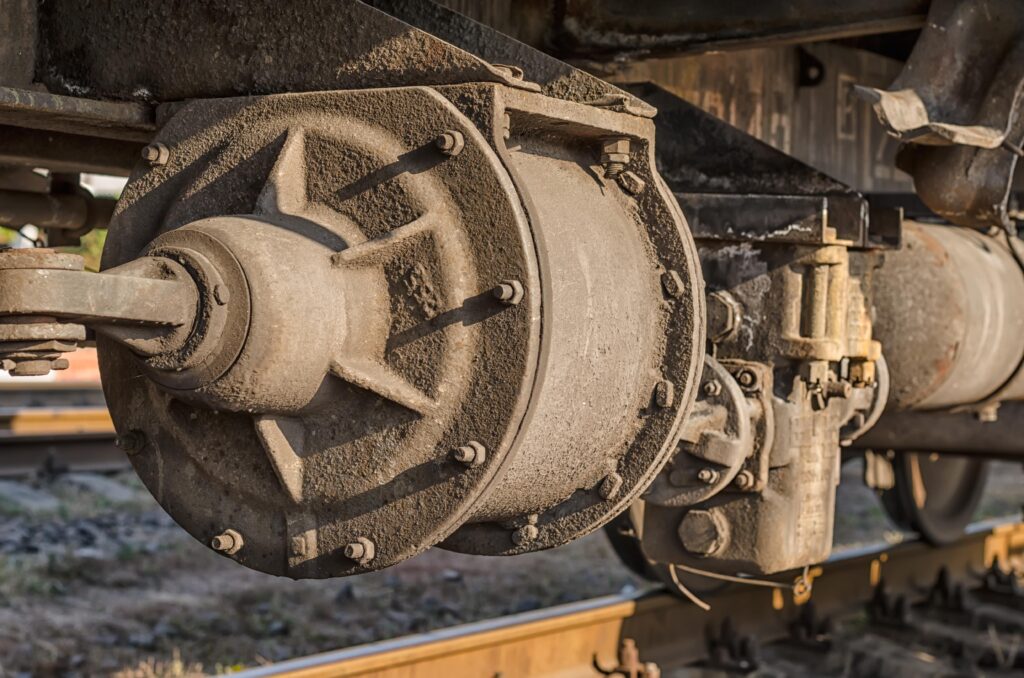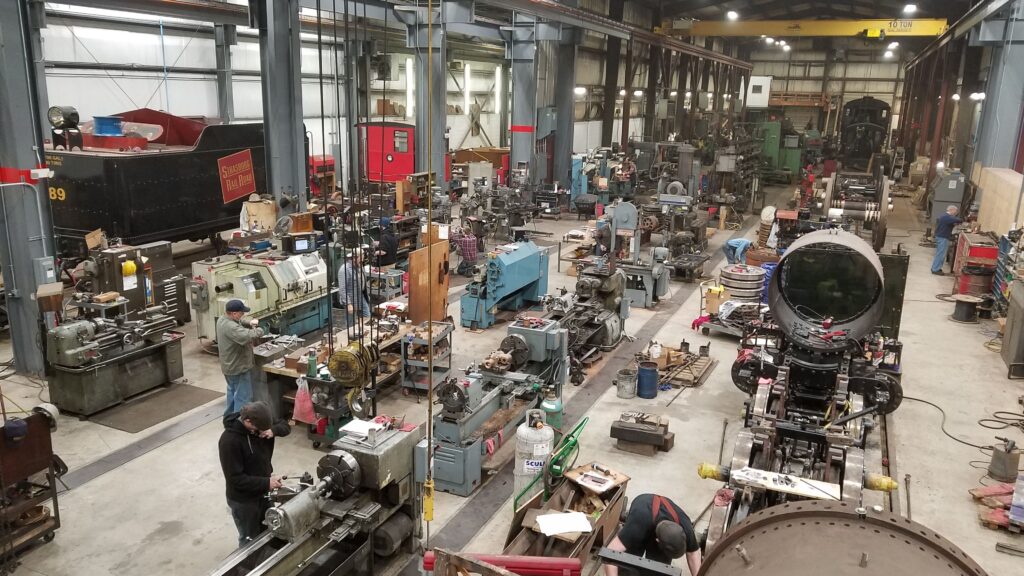Why the Railway Air Brake & Its Evolution Matters
One of the greatest inventions that changed the world was the steam locomotive. However, when the steam locomotive first came to be, its brakes weren’t as great at stopping when hooked up to other cars— until the creation of the air brake system. In the following, we will discuss the different types of railway air brakes, the railway air brakes evolution, and how did the railway air brake impact society.
How Do Air Brakes Work?
In some ways, steam locomotive air brakes resemble the brakes on a motor vehicle. They both play an important job—stopping your forward motion. Air brakes use pressure from compressed air to squeeze the wheels to a standstill.
Parts of an Air Brake
There are several different parts that make up an air brake system:
- A source of compressed air, like an air compressor, on the locomotive.
- A brake pipe to connect the locomotive with the cars on the train.
- A control valve, which can be either manual or automatic, to apply and release brakes.
- A brake cylinder with a piston that the compressed air acts on to transmit power from the compressed air through mechanical linkage to brake shoes that act on the wheels to slow movement.

Different Types of Air Brakes
Like most things in life, air brakes evolved over several different systems to become the sophisticated one that is still used today.
The Vacuum Brake
These were once used in the United States but were more common, and were used longer, in Europe. Today this system is now obsolete.
It had a continuous pipe called the train pipe, that ran the length of the train. Normally a partial vacuum is maintained in the train pipe, and the brakes are released. When air is admitted to the train pipe, that air acts against pistons in cylinders in each car.
A vacuum is sustained on the other face of the pistons so that a net force is applied. A mechanical linkage then transmits this force to brake shoes, which act on the wheel treads.
The working principles of a vacuum braking system and an air braking system are similar but the process and source to apply the brakes are different.
The Straight, or Direct, Air Brake
Straight air brakes work by supplying compressed air to the brake cylinders on the cars of a train from a single reservoir source mounted on the locomotive. In order to apply the brakes on a train with this system, the engineer would operate a valve in the locomotive cab that would send compressed air through the brake pipe connecting the cars with the locomotive to the brake cylinders on the train. The advantage of this system is its simplicity—there are very few parts.
However, for railroad service, it has several drawbacks. It did not work well on long trains because it would take time for the compressed air to reach the car furthest from the locomotive and the brakes on the train would not apply or release evenly. This could cause violent slack action in the train and put undue stress on couplings and cars.
Worse than that, if the train were to become parted in the middle, or a hose or pipe connection would burst, the entire train would be left without brakes and could run out of control.
The Automatic Air Brake
In an automatic air brake system, the air is supplied from the locomotive but stored in a reservoir on each individual car, connected by a brake pipe. The brake function on each car is then controlled by an automatic “control valve” on each car that responds to changes in brake pipe pressure.
The brakes are released when the system is fully charged with air at maximum system pressure. An engineer can apply them from the locomotive, using a manual brake valve that reduces pressure in the brake pipe.
Control valves sense the pressure change and allow compressed air, stored in the reservoir on each car, to move into the brake cylinder and apply the brakes on individual cars.
When the brake pipe pressure is recharged the brakes release. The control valves sense the pressure increase and vent the air out from the brake cylinder to the atmosphere. This causes the reservoirs on the individual cars to recharge, making them ready to apply again when needed.
The advantage of this system over straight air brakes is that the brakes will apply and release on trains, regardless of length, at nearly the same time and at the same speed, making train movement smooth.
They also are fail-safe, so if the train becomes parted or the brake pipe bursts, instead of having no brakes, the control valves on each car will sense the rapid brake pipe pressure drop and all brakes on the train will immediately go into an emergency application, bringing the whole train to a stop.
Life Before Air Brakes: An Air Brakes History
Before air brakes, trains employed an inefficient, and sometimes dangerous method to stop trains. They required employees known as brakemen to run atop the cars and set each car’s brakes by hand using its brake wheel. Basic brake shoes would press against the wheel slowing its movement.
However, it didn’t always stop the train in time so you could overshoot the station or stop too short. Brakemen were often maimed or killed by getting hit by low-hanging masonry or by falling off rail cars.
Early steam locomotives were supplied with steam brakes. The same steam source (the boiler) that provided locomotives the power to go also made them stop with a brake cylinder (similar to the later air brake cylinders.) These brakes were only available on the locomotive and were not powerful enough to stop trains with many cars.
Steam brakes couldn’t be applied to cars either, because the steam would cool and lose its power once it traveled any distance through a pipe away from the locomotive. Air brakes were that innovative piece that allowed entire trains to safely stop.
In 1869 George Westinghouse patented a new design for the railway air brake—what we know as the automatic air brake system. It was built by Westinghouse Air Brake Co. The company not only built the system but it manufactured equipment necessary for brakes, like the friction draft gear.
Westinghouse updated their systems to change with new technology and materials and better suit the operational needs of their railroad customers. As time went on, the company evolved from making just air brakes to manufacturing electromagnetic and electro-pneumatic brakes as well.
Railway air brakes weren’t immediately adopted by all railroads. Most railroad bosses weren’t sold on the idea since it meant retrofitting cars and locomotives at a large expense. However, they started to see the system’s value and its use became more common. The Railroad Safety Appliance Act of 1893 made the railway air brake invention mandatory on American trains. It was passed on March 2, 1893, and took effect in 1900 after a 7-year grace period.
How Did The Railway Air Brake Impact Society
Ultimately the railway air brake made trains safer. Trains were operated with greater control and accidents were often prevented. And workers, like brakemen, no longer had to ride on the tops of cars to apply brakes manually, thus reducing the dangers of their jobs.
The railway air brake system also permitted trains to travel at higher speeds. This allowed merchants to move their goods from one place to another at a higher profit. Higher speeds also allowed passengers to move more efficiently, allowing commuting from suburban areas into major cities and making things like weekend trips over longer distances practical.
Evolution of the Air Brake
The first brake systems were good for short, slow trains. Improvements were made and new systems were later created that worked better with longer, heavier trains.
Eventually, systems evolved specifically for passenger trains, which operated at higher speeds but were lighter in weight and shorter in length. This was an important development, since freight trains usually operated at lower speeds, but were much longer and heavier.
Of all the changes, the most rapid evolution occurred between the 1890s and 1930s, with many innovative systems being introduced. These systems comprised those that were applied to cars and those applied to locomotives.
Many small changes have occurred since World War II, but today’s automatic freight train brake systems are still very similar to the air brakes used on both passenger and freight trains at that time. While on the flip side, passenger train brake systems are now mostly electro-pneumatic and combine advanced electronic control with the power of compressed air.

Common Repair Problems with Air Brakes
All air brake systems require regular maintenance and repair, some of which are mandated by Federal regulations. Back in the day, railroads, as well as air brake system manufacturers like Westinghouse and New York Air Brake, employed large numbers of specialized craftsmen and specialized equipment.
Routine maintenance includes cleaning, oiling, and testing of the complex valves that operate and control the function of the brakes on cars and locomotives. This testing is done on specialized racks that brake valves are mounted to and that simulate the function of the valves in service.
When a valve is in service, it performs many functions simultaneously. The test racks allow the isolation of individual functions to ensure all parts of the valve are working properly or to diagnose problems among the many components in the valves.
Most of the testing equipment for the now-obsolete air brake systems, used on historic equipment, has long disappeared. At Strasburg Mechanical Services, we have several of these testing racks to use with these systems along with the original instructional material. This allows our highly skilled staff to help repair malfunctioning equipment and keep all valves in safe operating condition.
Strasburg Mechanical Services can diagnose and repair problems within the complete air brake system, from overhauling steam-driven air compressors to sourcing parts for obsolete systems, to brake valve repair and maintenance, as well as system troubleshooting.
At Strasburg Mechanical Services, we prefer to retain the original railway air brake systems on historic railroad equipment. This preserves the integrity of historic railroad artifacts and eliminates the need for a time-consuming, and expensive, modern conversion.
Preserving and caring for steam engines is our passion. Check out our website to see how Strasburg Mechanical Services’ expertise can help with your project.
